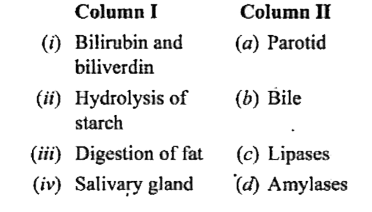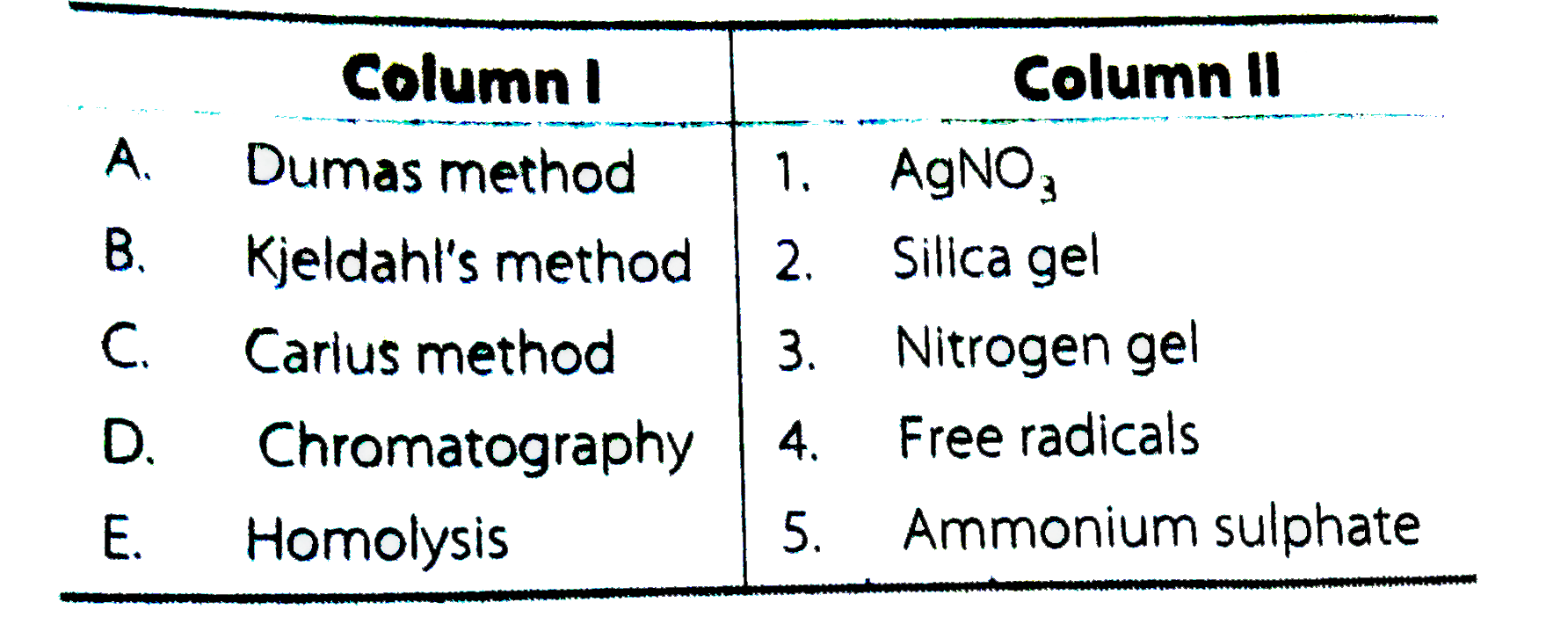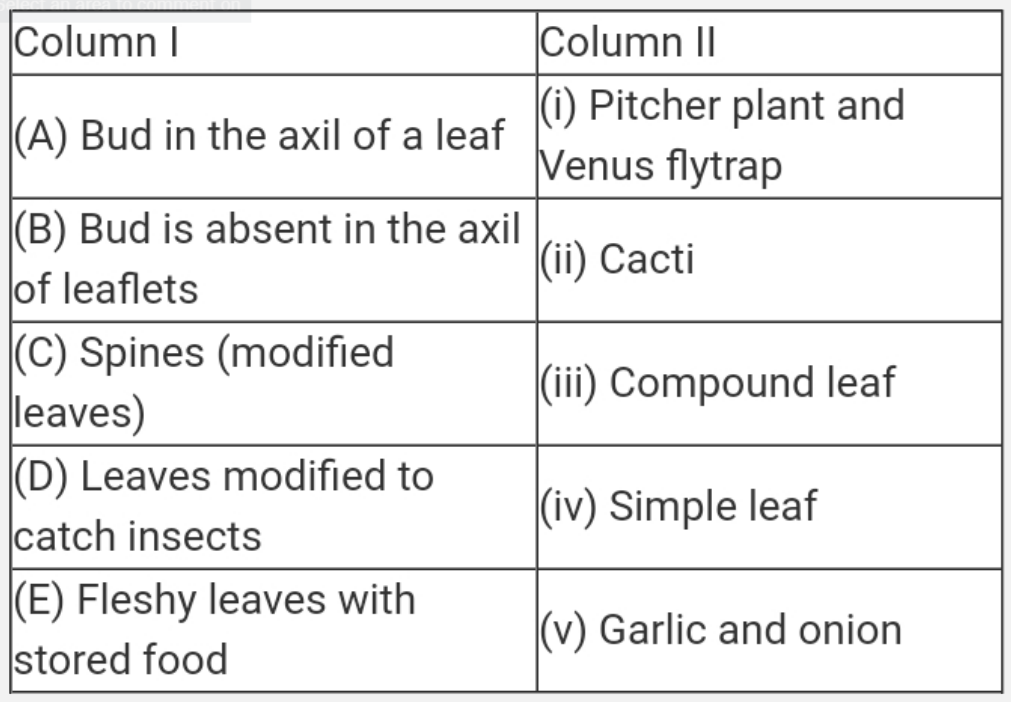Match the column I with column II
Column -IColumn-IIa.Horizontal and amacrine cell(i)Pivot pointb.Incus(ii)Olfactory epitheliumc.Bowman's gland(iii)Retinad.Cupula(iv)Crista(v)Macula
a(iv),b(v),c(ii),d(iii)
a(i),b(ii),c(iii),d(iv)
a(iii),b(i),c(ii),d(iv)
a(iii),b(i),c(ii),d(v)
The correct Answer is:C
To solve the matching question between Column I and Column II, we will analyze each item in Column I and find its corresponding match in Column II based on their definitions and functions.
1. Identify Horizontal and Amacrine Cells:
- Horizontal and amacrine cells are types of neurons found in the retina. They play a role in processing visual information by connecting photoreceptors to bipolar cells and ganglion cells.
- Match: (a) Horizontal and amacrine cell → (iii) Retina
2. Identify Incus:
- The incus is one of the three ossicles in the middle ear, which also includes the malleus and stapes. It is involved in the transmission of sound vibrations.
- The joint between the incus and stapes is known as a pivot joint.
- Match: (b) Incus → (i) Pivot point
3. Identify Bowman's Gland:
- Bowman's gland, also known as the olfactory gland, is located beneath the olfactory epithelium in the nasal cavity. It secretes mucus that helps dissolve odor molecules for olfaction.
- Match: (c) Bowman's gland → (ii) Olfactory epithelium
4. Identify Cupula:
- The cupula is a gelatinous structure found in the semicircular canals of the inner ear. It is associated with the crista, which contains hair cells that detect rotational movements of the head.
- Match: (d) Cupula → (iv) Crista
5. Identify Macula:
- The macula is a part of the inner ear involved in balance and is also a region in the retina responsible for high acuity vision. It is associated with both the vestibular system and the visual system.
- Since the macula is common to both the eye and ear, it can be matched with the remaining option.
- Match: (v) Macula
Final Matches:
- (a) Horizontal and amacrine cell → (iii) Retina
- (b) Incus → (i) Pivot point
- (c) Bowman's gland → (ii) Olfactory epithelium
- (d) Cupula → (iv) Crista
- (v) Macula → (v) Macula
Summary of Matches:
- a → iii
- b → i
- c → ii
- d → iv
- Horizontal and amacrine cells are types of neurons found in the retina. They play a role in processing visual information by connecting photoreceptors to bipolar cells and ganglion cells.
- Match: (a) Horizontal and amacrine cell → (iii) Retina
- The incus is one of the three ossicles in the middle ear, which also includes the malleus and stapes. It is involved in the transmission of sound vibrations.
- The joint between the incus and stapes is known as a pivot joint.
- Match: (b) Incus → (i) Pivot point
- Bowman's gland, also known as the olfactory gland, is located beneath the olfactory epithelium in the nasal cavity. It secretes mucus that helps dissolve odor molecules for olfaction.
- Match: (c) Bowman's gland → (ii) Olfactory epithelium
- The cupula is a gelatinous structure found in the semicircular canals of the inner ear. It is associated with the crista, which contains hair cells that detect rotational movements of the head.
- Match: (d) Cupula → (iv) Crista
- The macula is a part of the inner ear involved in balance and is also a region in the retina responsible for high acuity vision. It is associated with both the vestibular system and the visual system.
- Since the macula is common to both the eye and ear, it can be matched with the remaining option.
- Match: (v) Macula
- (a) Horizontal and amacrine cell → (iii) Retina
- (b) Incus → (i) Pivot point
- (c) Bowman's gland → (ii) Olfactory epithelium
- (d) Cupula → (iv) Crista
- (v) Macula → (v) Macula
- a → iii
- b → i
- c → ii
- d → iv
Topper's Solved these Questions
- NEURAL CONTROL AND COORDINATION Book:AAKASH INSTITUTE ENGLISHChapter:NEURAL CONTROL AND COORDINATION Exercise:Assignment SECTION - D (Assertion-Reason Type Questions )
Explore 10 Videos
- NEURAL CONTROL AND COORDINATION Book:AAKASH INSTITUTE ENGLISHChapter:NEURAL CONTROL AND COORDINATION Exercise:Assignment SECTION - B (Objective Type Questions )
Explore 29 Videos
- MORPHOLOGY OF FLOWERING PLANTSBook:AAKASH INSTITUTE ENGLISHChapter:MORPHOLOGY OF FLOWERING PLANTSExercise:TRY YOURSELF
Explore 38 Videos
- ORGANISMS AND POPULATIONS Book:AAKASH INSTITUTE ENGLISHChapter:ORGANISMS AND POPULATIONS Exercise:ASSIGNMENT (SECTION-D) (Assertion-Reason Type Questions)
Explore 15 Videos
Similar Questions
Knowledge Check
Match the Column I and Column II:
 A1. i. 2. ii 3. iii 4. ivB1. i 2. ii 3. iii 4. ivC1. i2. ii 3. iii 4. ivD1. i 2. ii 3. iii 4. iv
A1. i. 2. ii 3. iii 4. ivB1. i 2. ii 3. iii 4. ivC1. i2. ii 3. iii 4. ivD1. i 2. ii 3. iii 4. ivMatch the Column I and Column II:
 A1. i 2. ii 3. iii 4. ivB1. i 2. ii 3. iii 4. ivC1. i 2. ii 3. iii 4. ivD1. i 2. ii 3. iii 4. iv
A1. i 2. ii 3. iii 4. ivB1. i 2. ii 3. iii 4. ivC1. i 2. ii 3. iii 4. ivD1. i 2. ii 3. iii 4. iv








